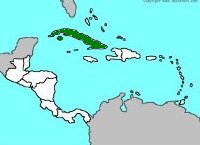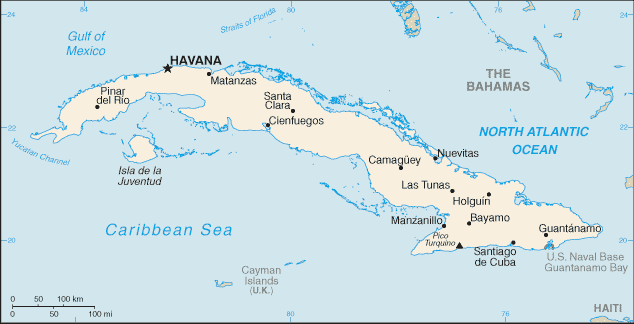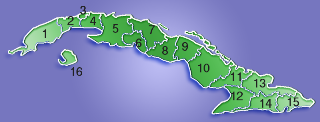Geography >> Central America >> Cuba History and Timeline
Cuba
Capital: Havana
Population: 11,333,483
The Geography of Cuba
Borders: Cuba is an island country located in the Caribbean. It has maritime (water) borders with several countries including the United States, The Bahamas, Jamaica, Haiti, and Honduras.
Total Size: 110,860 square km
Size Comparison: slightly smaller than Pennsylvania
Geographical Coordinates: 21 30 N, 80 00 W
World Region or Continent: Central America
General Terrain: mostly flat to rolling plains, with rugged hills and mountains in the southeast
Geographical Low Point: Caribbean Sea 0 m
Geographical High Point: Pico Turquino 2,005 m
Climate: tropical; moderated by trade winds; dry season (November to April); rainy season (May to October)
Major Cities: HAVANA (capital) 2.14 million (2009), Santiago de Cuba, Camaguey, Holguin
Major Landforms: Cuba is the 17th largest island in the world. Sierra Maestra mountain range, Sierra Cristal Mountains, Escambray Mountains, Pico Turquino Mountain, and Zapata Swamp.
Major Bodies of Water: Laguna de Leche, Zaza Reservoir, Rio Cuato River, Rio Almendares, Rio Yurimi, Caribbean Sea, Windward Passage, Yucatan Channel, Atlantic Ocean.
Famous Places: Morro Castle, El Capitolio, La Cabana, Havana Cathedral, Old Havana, Jardines del Rey, Zapata Peninsula, Trinidad, Santiago de Cuba, Baracoa
Economy of Cuba
Major Industries: sugar, petroleum, tobacco, construction, nickel, steel, cement, agricultural machinery, pharmaceuticals
Agricultural Products: sugar, tobacco, citrus, coffee, rice, potatoes, beans; livestock
Natural Resources: cobalt, nickel, iron ore, chromium, copper, salt, timber, silica, petroleum, arable land
Major Exports: sugar, nickel, tobacco, fish, medical products, citrus, coffee
Major Imports: petroleum, food, machinery and equipment, chemicals
Currency: Cuban peso (CUP) and Convertible peso (CUC)
National GDP: $114,100,000,000
Government of Cuba
Type of Government: Communist state
Independence: 20 May 1902 (from Spain 10 December 1898; administered by the US from 1898 to 1902)
Divisions: Cuba is divided into 15 provinces and one municipality (the island Isla de la Juventud). See the map below for the locations and names of the provinces. The largest of the provinces by population are Havana, Santiago de Cuba, and Holguin.
- Pinar del Rio
- Artemisa
- Havana
- Mayabeque
- Matanzas
- Cienfuegos
- Villa Clara
- Sancti Spiritus
- Ciego de Avila
- Camaguey
- Las Tunas
- Granma
- Holguin
- Santiago de Cuba
- Guantanamo
- Isla de la Juventud
National Anthem or Song: La Bayamesa (The Bayamo Song)
National Symbols:
- Bird - Tocororo
- Tree - Royal Palm
- Flower - White Mariposa
- Motto - Homeland or death
- Coat of arms - A shield showing a sunset, a key, a palm tree, and blue and white stripes
- Colors - Red, white, and blue
- Other symbols - Phrygian cap
Description of flag: The flag of Cuba was adopted on June 25, 1848. It has five blue and white stripes with a red triangle on the left (hoist) side. In the middle of the red triangle is a white star with five points. The three blue stripes represent the three divisions of Cuba, the white stripes represent the purity of the revolution, the red stands for the blood shed to free the country, and the star represents independence.
National Holiday: Independence Day, 10 December (1898); note - 10 December 1898 is the date of independence from Spain, 20 May 1902 is the date of independence from US administration; Rebellion Day, 26 July (1953)
Other Holidays: Triumph of the Revolution (January 1), Good Friday, Labour Day (May 1), Assault of the Moncada garrison Day (July 25), Independence Day (October 10), Christmas (December 25)
The People of Cuba
Languages Spoken: Spanish
Nationality: Cuban(s)
Religions: nominally 85% Roman Catholic prior to CASTRO assuming power; Protestants, Jehovah's Witnesses, Jews, and Santeria are also represented
Origin of the name Cuba: The name "Cuba" comes from the language of the original Taino people who lived on the island before Europeans arrived. It likely means "where fertile land is abundant."

Alicia Alonso
- Alicia Alonso - Ballerina
- Desi Arnaz - Singer and actor
- Fulgencio Batista - Dictator
- Jose Canseco - Baseball player
- Fidel Castro - Dictator of Cuba
- Celia Cruz - Singer
- Gloria Estefan - Singer
- Daisy Fuentes - Actress
- Andy Garcia - Actor
- Che Guevara - Revolutionary
- Jose Marti - Independence fighter
- Yasiel Puig - Baseball player
Geography >> Central America >> Cuba History and Timeline
** Source for population (2019 est.) is United Nations. GDP (2011 est.) is CIA World Factbook.




